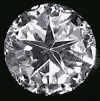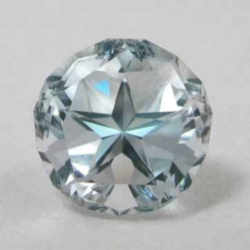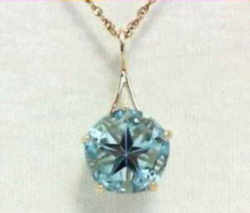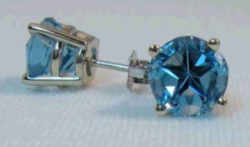
Texas Symbols
- State Resources
- » 50 States
- » Texas
- » Symbols
Texas State Gemstone Cut
Lonestar Cut
Adopted on May 25, 1977.



Crown (left) Pavilion (right)
The Lone Star Cut, designed by brothers Dr. Paul W. Worden, Jr. and Gary B. Worden, became the official state gemstone cut of the State of Texas when Governor Dolph Briscoe signed House Concurrent Resolution No. 97 on May 25, 1977.Lonestar Cut: Texas State Gemstone or Gem Cut

The Lone Star Cut, designed by two native Texans, is a special gemstone cut that reflects a five-pointed star (the lone star of Texas) during December 1973 and January 1974 by Dr. Paul W. Worden, Jr. and his brother Gary B. Worden, a science teacher and faceter. Dr. Worden , a physicist at Stanford University was visiting his brother in Texas for the holidays and wanted to learn to facet. Gary took him through the basics and Paul designed and cut a five pointed star in a small synthetic golden sapphire. Not satisfied with the excessive reflections in this stone, Paul returned to Stanford and redesigned the cut with the aid of a computer. He sent the result to Gary to evaluate, finalize and cut. The result: a perfect five pointed star, not dim as with other designs cut below the critical angle or left unpolished, but bright and reflective, visible immediately from as far away as the stone is clearly visible.

The angles for the pavilion make the star a type of corner reflector, which means any light striking it is reflected back to the source. Therefore, what you see when you look at the star is actually the reflection of your eye. The rest of the pavilion facets are designed to let light from other reflections escape, enhancing the star even more. The striking appearance of the star is due both to the fact that it is a corner reflector, and the fact that the rest of the stone is not. A deviation of only a degree from the calculated angles and much of the effect is lost.

Rather than try to copyright the design, which could be thwarted with only a few minor changes, it was decided to first publish it (Gems and Minerals magazine, Feb. 1977-No. 472, pages 8,67). A cousin of the brothers, Win Brown, then a Midland County commissioner and also a faceting enthusiast, suggested getting the star design adopted as the Texas State Gemstone Cut. Win convinced Midland Rep. Tom Craddick to successfully sponsor a measure, House Concurrent Resolution #97, which was signed by Governor Dolph Briscoe on May 25, 1977. Dr. Paul W. Worden and his brother, Gary B. Worden, are mentioned in the document as "two native Texans". In this way the design is free to be used by anyone with the equipment to cut it.
Source: Gary's Gems: Custom manufacturer of fine jewelry, especially faceted stones, custom mounts, and other unique jewelry. Blue topaz, the state gemstone of Texas, is available cut in the Official State Gemstone Cut of Texas, the LONE STAR CUT
The Largest Known Lone Star Cut Blue Topaz
Lone Star Cut Blue Topaz
176.30 Carats
32.22 X 25.04mm
Texas House Concurrent Resolution No. 97
H. C. R. No. 97
HOUSE CONCURRENT RESOLUTION
WHEREAS, The flag of Texas, the public symbol for all to see, has a lone star as its prominent feature; and
WHEREAS, This is reflected in the State slogan "Texas - The Lone Star State" ; and
WHEREAS, A special gemstone cut known as the Lone Star Cut has been designed by two native Texans; and
WHEREAS, Any gems one may be cut in this manner, including the State Gem, the Blue Topaz; and
WHEREAS, The special characteristic of the Lone Star Cut is the appearance to the viewer when looking directly into the stone, in that it reflects
the five-pointed star; now, therefore, be it
RESOLVED by the House of Representatives of the State of Texas, the Senate concurring. That the Lone Star Cut be and is hereby designated as the official
State Gemstone Cut of Texas; and, now, be it further
RESOLVED, That the specifications for faceting the Lone Star Cut are for an 80 index gear and shall be as follows:
PAVILION
1. Cut 10 facets at 45°. Index 4-12-20-28-36-44-52-60-68-76.
2. Cut 5 facets at 54°, until the star is a measured 65 percent of the diameter of the stone. Index 80-16-32-48-64.
3. Cut 10 facets at 60.7°. Index 2-14-18-30-34-46-50-62-66-78. These are to meet the points of the star exactly.
4. Cut 5 facets at 65°. Index 8-24-40-56-72. These should also meet the points of the star exactly.
5. Prepolish in the same order, then polish from the culet to the girdle.
CROWN
1. Cut 10 facets at 41.5°. Index 2-14-18-30-34-46-50-62-66-78. These should be cut until the girdle is of the proper thickness.
2. Cut 5 facets at 52.1°. Index 8-24-40-56-72. Cut these until they match the corresponding facets of the pavilion in width at the girdle. This will
insure the proper size for the table.
3. Cut 5 facets at 30°. Index 80-16-32-48-64.
4. Cut the table at 0° until the 30° facets meet at a point.
5. Prepolish in the same order, then polish in reverse order. If desired, the table may be cut and polished last; it depends on your machine. The girdle
may be polished or not, as you wish.
House Concurrent Resolution No. 97, 65th Legislature, Regular Session (1977)







